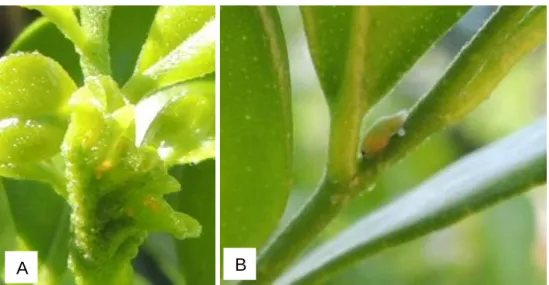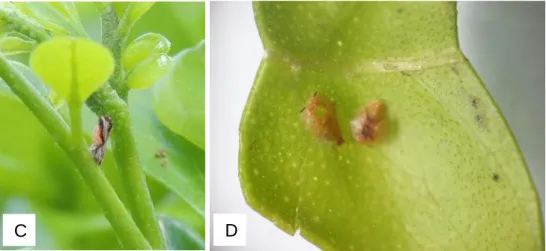SCIENTIFIC NOTE
FIRST REPORT OF INVASIVE Diaphorina citri (HEMIPTERA: LIVIIDAE) AND ITS ASSOCIATED PARASITOID Tamarixia radiata (HYMENOPTERA: EULOPHIDAE)
IN THE ESPÍRITO SANTO STATE, BRAZIL
Renan Batista Queiroz1, Cesar José Fanton1, José Salazar Zanuncio Júnior1, David dos Santos Martins1, Maurício José Fornazier1
1 Researcher D.Sc., Instituto Capixaba de Pesquisa, Assistência Técnica e Extensão Rural, Incaper. Cx. Postal 01146, CEP 29052-010. Vitória - ES. E-mail: renan.queiroz@incaper.es.gov.br; fanton@incaper.es.gov.br;
jose.zanuncio@incaper.es.gov.br; davidmartins@incaper.es.gov.br; fornazier@incaper.es.gov.br.
ABSTRACT- Invasive species are responsible to cause several problems for both environment
and managed systems, such as agriculture. The main citrus pest insect worldwide is the invasive species Asian citrus psyllid Diaphorina citri (Hemiptera: Liviidae), a vector of the 'Candidatus Liberibacter spp.' that causes the citrus disease known as greening or Huanglongbing (HLB). This insect vector was found widespread in Espírito Santo State, Brazil, and Tamarixia radiata (Hymenoptera: Eulophidae) was a parasitoid associated with its nymphs. In this study, we report the range expansion of this insect vector in Brazil, and discuss some measures to avoid the HLB disease entrance in the state, and D. citri populations’ management.
KEYWORDS: Asian citrus psyllids. Invasive species. Insect vector. Huanglongbing.
RESUMO- Espécies invasoras são responsáveis por causar vários problemas tanto para o meio
ambiente quanto para os sistemas manejados, como a agricultura. O principal inseto praga de citros em todo o mundo é a espécie invasora, Diaphorina citri (Hemiptera: Liviidae), psilídeo vetor da bactéria "Candidatus Liberibacter spp.", agente etiológico da doença cítrica conhecida como greening ou Huanglongbing (HLB). Este inseto vetor foi encontrado de forma generalizada no Espírito Santo, Brasil. O parasitoide Tamarixia radiata (Hymenoptera: Eulophidae) também foi encontrado associado às ninfas de D. citri. Neste estudo, relatamos o grande alcance desse inseto vetor no Brasil e discutimos algumas medidas para evitar a entrada da doença HLB no estado, bem como o manejo das populações de D. citri.
PALAVRAS-CHAVE: Psilídeo. Espécie invasora. Inseto vetor. Huanglongbing.
Invasive species are one of mankind’s greatest challenges, which cause several problems in natural and managed ecosystems, including agricultural where economic losses can be severe (BENNETT, 2013). Biological invasions can cause new species interactions, for example between plants, pathogens, and insects vectors (RICHARDSON et al. 2000). Currently, the invasive species Asian citrus psyllid (Diaphorina citri) Kuwayama (Hemiptera: Liviidae) is considered the main citrus pest in the world (HALL et al. 2013). This species is able to transmit the ‘Candidatus Liberibacter spp.’, an endogenous and phloem-limited bacterium, which causes a destructive citrus disease previously known as greening and nowadays as Huanglongbing (HLB) (HALBERT and MANJUNATH, 2004; BOVÉ 2006). Furthermore, D. citri is also able to transmit plant pathogen ‘Candidatus Phytoplasma aurantifolia’, the etiological agent of Witches’ Broom Disease of Lime (WBDL) (QUEIROZ et al., 2016). Diaphorina citri was reported for the first time in Brazil at least 70 years ago (LIMA, 1942) and it has a wide range of hosts, particularly plant species belong to the family Rutaceae (HALBERT and MANJUNATH, 2004).
Until recently, the American continent was HLB disease free, but in March 2004 the disease symptoms were observed in the São Paulo state, Brazil, and in August 2005 in Florida,
Adults, nymphs and eggs of Diaphorina citri were collected in seven different places in the Espírito Santo state (Figure 1). In the Northern, it was found in the Research Experimental Station of Incaper (19°25'01.5"S 40°04'44.8"W), and Santa Luzia Farm in the municipality of Linhares (19°33'30.6"S 40°10'40.0"W); Research Experimental Station of Incaper (Instituto Capixaba de Pesquisa, Assistência Técnica e Extensão Rural) in Sooretama (19°07'14.8"S 40°05'01.5"W), Marilândia (19°24'20.4"S 40°32'30.2"W), and Cachoeiro do Itapemirim (20°45'12.0"S 41°17'25.6"W). In Southern D. citri was found in the municipalities of Ibatiba (20°12'49.23"S 41°29'44.07"W) and Guaçuí (20°47'8.68"S 41°49'24.23"W) (Figure 2). Samples were collected in the canopies of citrus (Citrus sinensis), and orange jasmine (Murraya paniculata), and associated with shoots and leaves. All the samples were infested with D. citri. Nymphs of D. citri were placed in plastic pots with fresh shoots of M. paniculata to observe parasitoid emergence (Figure 1), which about 50% of the nymphs had parasitoid emergence. Parasitoids emerged were preserved on 70% alcohol and then send to species identification by Dr. Valmir Antonio Costa from the Biological Institute of the Department of Agriculture and Supply of the São Paulo State.
Figure 1. Diaphorina citri (Hemiptera: Liviidae) eggs (A), nymph (B), and adult (C) on shoots of the orange jasmine (Murraya paniculata) plants at Research Experimental Station of Incaper in Linhares, Espírito Santo state, Brazil. Detail of the parasitized nymphs by Tamarixia radiata (Hymenoptera: Eulophidae) (D). March 2015.
Figure 2. Occurrence of Diaphorina citri in the Espírito Santo state. The different colors represent the main regions in the Espírito Santo state. Gray circle represents the places where D. citri were collected.
disease symptoms may delay to appear, and some PCR techniques cannot detect the pathogen when it is still in low levels on plants (BOVÉ, 2006). Roguing of ‘Ca. Liberibacter spp.’ infected plants followed by chemicals is the main control method to D. citri. However, chemicals may induce resistant populations (TIWARI et al., 2011) and may reduce natural enemies, which can cause the secondary pest outbreaks (DUTCHER, 2007). Another management measure to avoid the ‘Ca. Liberibacter spp.’ spread is acquire citrus seedlings from nurseries protected with anti-aphid screens and seedlings certified by inspection governmental agencies, for example, Coordenadoria de Defesa Agropecuária (CDA) of the São Paulo state (FUNDECITROS, 2017).
Tamarixia radiata (Waterston 1922) (Hymenoptera: Eulophidae) was found associated with D. citri nymphs (Figure 1), and this is a potential parasitoid to be used on biological control programs. This is an ectoparasitoid, a single adult can parasites up to 500 nymphs (CHIEN, 1995; SKELLEY and HOY, 2004) with a parasitism rate > 77% (GÓMEZ-TORRES et al., 2012), and able to attack from third to fifth instars of D. citri (MCFARLAND and HOY, 2001; SKELLEY and HOY, 2004). Therefore, this is a parasitoid that should be considered in management programs for this pest in Espírito Santo state, Brazil.
Diaphorina citri was found on elevations higher than 600 m as in Guaçuí and Ibatiba, but in lower populations. However, there is a strong evidence that D. citri populations are negatively correlated with elevation, and suggests that the lower abundance of D. citri at higher elevations results in lower HLB disease incidence. It may be a consequence of differences in temperature, air pressure, oxygen levels, ultraviolet light, or other factors alone or combined (JENKINS et al., 2015). New studies should be carried out to confirm the correlation between D. citri population level and altitude. Since that climate conditions are fundamental to D. citri management, particularly to avoid citrus cultivation in lower regions, to produce seedlings in higher altitudes, and therefore to prevent the disease spread by insect vector. Thus, future studies should be directed towards to avoid the HLB disease entrance in the Espírito Santo state, and to D. citri populations’ management.
ACKNOWLEDGEMENTS
We would like to thank Dr. Valmir Antonio Costa from the Biological Institute of the Department of Agriculture and Supply of the São Paulo State for the parasitoid identification.
REFERENCES
AYRES, A.J. et al. Current status of citrus HLB and efforts toward its eradication in São Paulo State, Brazil. Proceedings of 2nd International Citrus Canker and Huanglongbing
BENNETT, A.E. Can plant–microbe–insect interactions enhance or inhibit the spread of invasive species? Functional Ecology, v. 27, p. 661-671, 2013.
BOVÉ, J.M. Huanglongbing: A destructive, newly-emerging, century-old disease of citrus.
Journal of Plant Pathology, v. 88, p. 7-37, 2006.
CHIEN, C.C. The role of parasitoids in the pest management of citrus psyllid. Proceedings of
the Symposium on Research and Development of Citrus. Taiwan, p. 245-261, 1995.
COLETTA-FILHO HD. et al. First Report of the Causal Agent of Huanglongbing (“Candidatus Liberibacter asiaticus”) in Brazil. Plant Disease, v. 88, p. 1382, 2004.
DUTCHER, J.D. A review of resurgence and replacement causing pest outbreaks in IPM. In CIANCIO, A.; MUKERJI, K.G. (Ed.). General concepts in integrated pest and disease
management. Springer, Dordrecht, The Netherlands, p. 27-43, 2007.
FUNDECITROS. Fundo de Defesa da Citricultura.
http://www.fundecitrus.com.br/doencas/greening/10. (last accessed 04 Sep 2017).
GÓMEZ-TORRES, M.L. et al. Life table of Tamarixia radiata (Hymenoptera: Eulophidae) on Diaphorina citri (Hemiptera: Psyllidae) at different temperatures. Journal Economy
Entomology, v. 105, p. 338-43, 2012.
HALBERT, S.E.; MANJUNATH, K.L. Asian citrus psyllids (Sternorrhyncha: Psyllidae) and greening disease of citrus: A literature review and assessment of risk in Florida. Florida
Entomologist, v. 87, p. 330-353, 2004.
HALL, D.G. et al., Asian citrus psyllid, Diaphorina citri, vector of citrus huanglongbing disease. Entomologia Experimentalis et Applicata, v. 146, p. 207-223, 2013.
IBGE. 2013. Produção Agrícola Municipal.
http://www.ibge.gov.br/estadosat/temas.php?sigla=es&tema=lavourapermanente2013. (last accessed 22 Feb 2015).
INCAPER. 2015. Boletim da Conjuntura Agropecuária Capixaba, Ano I, nº3. Vitória, Brasil. 10p.
JENKINS, D.A. et al. Diaphorina citri (Hemiptera: Liviidae) Abundance in Puerto Rico Declines with Elevation. Journal Economy Entomology, v. 108, p. 252-258, 2015.
LIMA, A.C. Insetos do Brasil, Homópteros. Rio de Janeiro, Escola Nacional de Agronomia. 1942.
MARSARO JÚNIOR et al. Primeiro registro de Diaphorina citri Kuwayama, 1908
(Hemiptera: Liviidae) para o Estado de Roraima, Brasil. Revista de Agricultura, v. 83, p. 183-186, 2014.
MCFARLAND, C.D.; HOY, M.A. Survival of Diaphorina citri (Homoptera: Psyllidae) and its two parasitoids, Tamarixia radiata (Hymenoptera: Eulophidae) and Diaphorencyrtus
75, p. 65-93, 2000.
SAKAMAKI, Y. Possible migration of the Asian citrus psyllid, Diaphorina citri Kuwayama (Homoptera: Psyllidae) between and within islands. Occasional Papers Kagoshima
University Research Center for the Pacific Islands, v. 42, p. 121-125, 2005.
SILVA, A.G.A. et al. Quarto catálogo dos insetos que vivem nas plantas do Brasil. Seus parasitos e predadores. Ministério da Agricultura, Rio de Janeiro, Brasil, 1968.
SKELLEY, L.H.; HOY, M.A. A synchronous rearing method for the Asian citrus psyllid and its parasitoids in quarantine. Biological Control, v. 29, p. 14-23, 2004.
TEIXEIRA, D.C. et al. First report of a huanglongbing-like disease of Citrus in São Paulo State, Brazil, and association of a new Liberibacter species, “Candidatus Liberibacter americanus”, with the disease. Plant Disease, v. 89, p. 107, 2005.
TIWARI, S. et al. Insecticide resistance in field populations of Asian citrus psyllid in Florida.
Pest Management Science, v. 67, p. 1258-1268, 2011.
Recebido para publicação: 24 de junho de 2017 Aprovado: 12 de julho de 2017.

